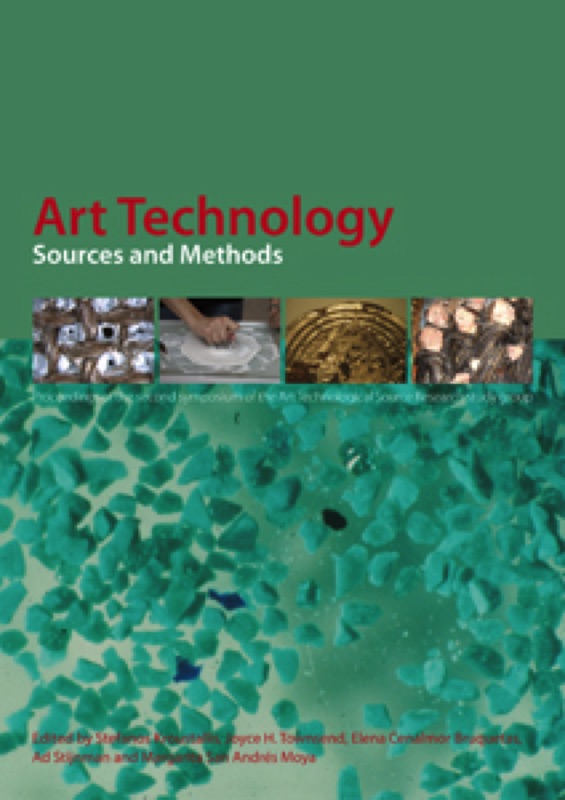The study of art technology has gained importance in recent decades as a relevant source of information, not only for determining the material history of an art object, but also for contributing to cultural aspects concerning its creation and use: aesthetic, economic, social, religious, etc. Often the results of such investigations are carried out within a narrow discipline and are only made available within it. The success or failure of multidisciplinary approaches depends on the capacity to share information. Specialised researchers on sources relevant to the history, technology and production of art object as a whole can overcome this obstacle. But under what disciplinary aegis?
This volume contains papers in either English or Spanish, with abstracts in both languages, which address these issues through case studies, paying special attention to methodology. Different types of art technological sources and the theory of source research are examined. While there is an emphasis on textual sources, which are the most widely available and relatively easy to understand, an extensive range of subjects is covered: Hispano-Islamic gilding techniques; mediaeval recipe books and Baroque painting treatises; precolonial and colonial Latin American pigments; industrial archives and patents; realia from the 18th and 19th centuries; audiovisual sources for contemporary art; and the importance as a source of laboratory analysis and reconstructions of historic recipes. All the studies are based on an unambiguous working method and accurate interpretation of results.
Proceedings of the second symposium of the Art Technological Source Research study group.
Foreword
Prefacio
Acknowledgements
Agradecimientos
Materials for art technological source research: theoretical issues
Ad Stijnman
Towards a new discipline?
Jo Kirby
Asymptotically approaching the past: historiography and critical uses of sources in art technological source research
Mark Clarke
Reading the past: methodological considerations for future research in art technology
Stefanos Kroustallis
Las dificultades especificas de la terminologia: a proposito de la traduccion comentada al aleman de los capitulos sobre las tecnicas pictoricas de tres tratados
barrocos espanoles
Corinna Gramatke
Los recetarios medievales de tecnologia artistica
Stefanos Kroustallis
Llaves y secretos para el estudio de los materiales del color
Gabriela Siracusano
La revista como fuente de informacion para la tecnologia artistica: Carlos de Haes y su articulo 'Dibujo al carbon (aplicado al paisaje)'
Elena Cenalmor Bruquetas
La obtencion de pigmentos azules para las obras de Filipe II: comercio europeo y americano
Rocio Bruquetas Galan
Patents as a source of documentation for studying art technology
Margarita San Andres Moya and Silvia Garcia Fernandez-Villa
Nineteenth-century English artists' colourmen's archives as a source of technical information
Mark Clarke
Las tecnicas de policromia barroca del noroeste de Portugal en los contratos y los tratados pictoricos
Carlos Nodal Monar y Ana Calvo Manuel
El retoque a seco: evolucion a traves de la historia de la pintura mural al fresco
Jose Luis Regidor Ros, Eric Rojas Marquez y Juan Valcarcel Andres
Seventeenth-century machines for drawing celestial spheres
Arie Wallert
La mesa de trabajo de Fortuny
Carmina Admella Baulies, Benoit V. de Tapol y Nuria Pedragosa Garcia
The painter's studio as a documentary source: a study of the final decades of Joan Miro
Silvia Garcia Fernandez-Villa and Enric Juncosa Darder
Marks engraved on gilded surfaces of paintings on wood: types and methodology
Eva Lopez Zamora and Consuelo Dalmau Moliner
New technologies: new protocols
Jorge Garcia Gomez-Tejedor
Islamic gilding technology: written sources and scientific analyses
Joaquin Barrio Martin
Analyses of dyes in the map collection of the Real Chancilleria of Granada
Ana Lopez-Montes, Rosario Blanc Garcia, Teresa Espejo Arias and Jose Luis Vilchez Quero
Analysis of pigments for miniatures
Cecilia Ronnerstam
A micro-Raman spectroscopy study of the formation of lead dioxide from lead white
Cristina Aibeo, Emilio Mario Castellucci, Mauro Matteini, Barbara Sacchi, Angela Zoppi and Cristiana Lofrumento
Cinnabar or vermilion?
Renata Garcia Moreno and Nicolas Thomas
Identification of pigments in a 17th-century coloured map using micro-Raman spectroscopy and PIXE
Nuno Filipe Camarneiro Mendes, Emilio Mario Castellucci, Cristiana Lofrumento, Angela Zoppi, Pier Andrea Mando and Novella Grassi
Sizing layers for oil painting in westem European sources (1500-1900): historical recipes and reconstructions
Maartje Stols-Witlox
Reconstruction of tempera painting techniques: some examples, including gesso sottile
Renate Woudhuysen-Keller
Characterisation of purified verdigris obtained according to Recipe 101 of the Manoscritto Bolognese
Margarita San Andres Moya, Jose Manuel de la Roja, Natalia Sancho Cubino and Sonia Santos Gomez
Reconstruction of documented preparation methods for gesso grosso and gesso sottile in Spanish School panel paintings
Sonia Santos Gomez, Margarita San Andres Moya and Alfonso Rodriguez
Cochineal use in pre-Columbian.paintings
Ariadna Cervera, Renata Garcia-Moreno and Javier Vazquez
